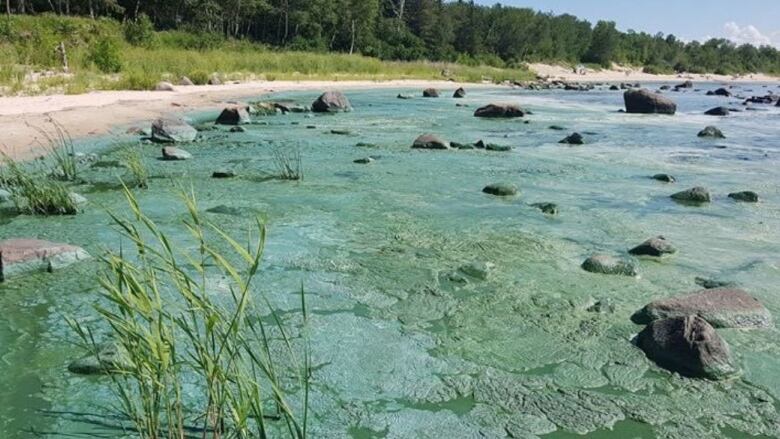Councillors want Winnipeg to act on plan to remove phosphorus from waste water
Proposal for temporary phosphorus reduction not doable, senior managers say

City Coun. Kevin Klein is challenging senior water and waste department managers' rejection of a proposedway to remove phosphorus from the water the city sends to Lake Winnipeg.
Klein, Transcona's Shawn Nason andElmwood-East Kildonan's Jason Schreyer will introduce a motion at city council on Thursday for Winnipeg to adjust the use of ferric chloridein the sewage treatment process.
The proposal by theInternational Institute for Sustainable Development and the Lake Winnipeg Foundationwas raised earlier this month at a water and waste committee meeting.
The infrastructure upgrades would cost $3 million and require a further $2 million a year in operating expenses, saysa briefing provided by the foundation and the IISD, which is based in Winnipeg.
The city had engineering consultant AECOM examine eight short-term solutions to reduce the phosphorus it sends into the lake, including the ferric chloride proposal from the lake foundation and the IISD. AECOM said the ferric chloride proposal was the best option, but managers in the water and waste department said it wasn't operationally feasible.
Excess phosphorus is a significant contributor to potentially toxic algae blooms found in Lake Winnipeg.
Klein, who represents Charleswood-Tuxedo-Westwood, said the city is offloading the damage from phosphorus onto the future.
"If we don't do something now, we are just adding to the problem over the next several years," Klein said.
It's hoped that adjusting the amount of ferric chloride and changing where it's added in the treatment process will get rid of as much as 70 per cent of the phosphorus coming from Winnipeg's sewage system.
The IISD study says adding ferric chloride at the preliminary treatment stage allows the chemical to bind to phosphorus so it settles out of the waste stream and into the sludge.
Then the phosphorus, now in particulate form, can be removed through existing processes of the treatment system.

The IISD's director of water management wants the city to either pursuethat option or choose another one.
"The proposal that we put forward is technically sound. It's financially sound. We believe in it, but we'd be happy if the city came back and saidthere is another interim solution that we would prefer to use given our specific conditions and limitations," Dimple Roy said.
A consulting engineer supported the option in a report attached to the City of Winnipeg's request to the province for an alteration to its licence for the North End Water Pollution Control Centre.
- City rejection of phosphorus reduction plan shows 'embarrassing lack of leadership,' advocate says
- Water, sewer rates on the rise, along with price tag for sewage-treatment upgrades
The city wants an extension of its current licence until 2021 because it can't meetstandardsfor the treatment of phosphorus, nitrogen and ammonia set to come into effect in December; theyrequire the city to haveno more than 1 milligram of phosphorus per litre in its treated effluent.
The current total phosphorus in the effluent coming from the plant is approximately 3times higher than the licence will allow.
In 2003, the Manitoba Clean Environment Commission prompted the province to order Winnipeg to improve its sewage-treatment processes. The city was told to upgrade its North End, South End and West End sewage treatment plants.
The North End treatment plant requires $1.8 billion in upgrades and the project is split into three parts, as the work is complicated and expensive.The city has yet to reach an agreement with the provincial and federal governments on sharing the costs of upgrades to the North End Water Pollution Control Centre.
The city declined to comment on Coun. Klein's motion or the proposal by the IISD or the Foundation.
However, earlier this month, the director of the city's water and waste department repeatedly told councillors the ferric chloride option wasn't viable.
"We reviewed it as part of our interim options and what we are saying is that operationally we can't do that. We cannot do what they said we could do we do not have the capacity for the solids that would be generated by adding ferric at the front end of the plant," Moira Geer told councillors on the water and waste committee.
Geersaidthe department was looking at options to reduce the phosphorus load and asked for time to find the right solution.
Klein says that isn't a good enough answer.
"I don't think that it shows good leadership. I think it shows poor management. I think it shows very little social responsibility to sit here and see an opportunity to address the problem for now," Klein said.
Geer told the committee there may be a "misconception" about Winnipeg's responsibility for the phosphorus sent into Lake Winnipeg, saying the city'sshare is three to fiveper cent of the total.
Roy at the IISD confirmed the number was correct, but said Winnipeg is the largest single-point source emitterof phosphorus.
"It's the only place where we have a dripping tap that we can turn off. Every other contribution, so the rest of the95 per cent, is coming from the landscape," Roy said.












_(720p).jpg)


 OFFICIAL HD MUSIC VIDEO.jpg)
.jpg)



























































































